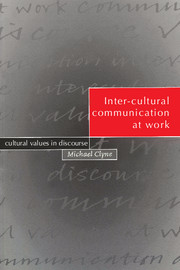Book contents
- Frontmatter
- Contents
- List of figures
- List of tables
- Acknowledgements
- 1 Introducing the field
- 2 Setting up the project
- 3 Speech acts in inter-cultural discourse
- 4 Variation in communication patterns and inter-cultural communication breakdown in oral discourse
- 5 Written discourse across cultures
- 6 Towards a linguistics of inter-cultural communication
- 7 Some theoretical and practical implications
- Appendix 1 Non-key informants
- Appendix 2 Index of informants' pseudonyms, ages, and ethnolinguistic background
- Appendix 3 Two long transcriptions
- References
- Index of text transcriptions
- Index of names
- Index of subjects
3 - Speech acts in inter-cultural discourse
Published online by Cambridge University Press: 05 June 2012
- Frontmatter
- Contents
- List of figures
- List of tables
- Acknowledgements
- 1 Introducing the field
- 2 Setting up the project
- 3 Speech acts in inter-cultural discourse
- 4 Variation in communication patterns and inter-cultural communication breakdown in oral discourse
- 5 Written discourse across cultures
- 6 Towards a linguistics of inter-cultural communication
- 7 Some theoretical and practical implications
- Appendix 1 Non-key informants
- Appendix 2 Index of informants' pseudonyms, ages, and ethnolinguistic background
- Appendix 3 Two long transcriptions
- References
- Index of text transcriptions
- Index of names
- Index of subjects
Summary
The interactions
In this chapter, I shall discuss some of the interactions that form part of our corpus from the point of view of their predominant communicative function or intent. The purpose of this is twofold. There are few corpuses of workplace communication that have been described in detail. Such a description may contribute to an appreciation of the diversity of the categories. Moreover, because of the inter-cultural nature of the communication, it is possible to focus on cultural variation (as well as gender variation and variation between workplaces) in the incidence of particular speech acts and the way in which they are performed. A more ‘holistic’ treatment of the corpus may be found in Chapter 4.
Because of the manner in which our data was collected, the tapes include periods of silence, speech that is inaudible because of industrial noise, and brief question-answer interactions of the kind:
– do you know where Jack is.
– yes he went over there.
Such interactions are generally successful and, if so, will not be discussed in this account. Also, responses to such questions are often non-verbal (i.e. by gesture).
Some of the interaction sequences in the corpus are simple in that they involve a single speech act and perhaps a response to it (i.e. adjacency pair) and a lead-up. There may be a repetition or paraphrase, e.g.
don't do that don't do that.
tell him to stand in the queue make him stand in the queue.
- Type
- Chapter
- Information
- Inter-cultural Communication at WorkCultural Values in Discourse, pp. 48 - 89Publisher: Cambridge University PressPrint publication year: 1995

